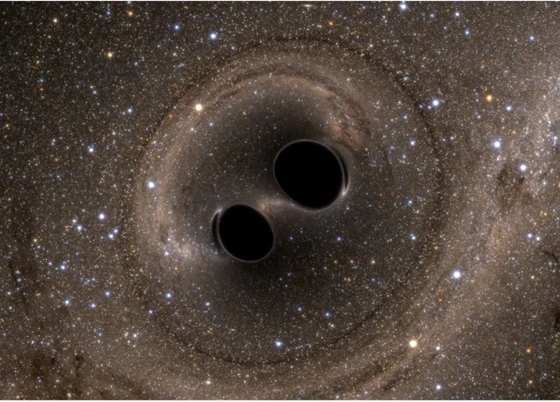Throughout the vast expanse of the universe, amidst the countless celestial phenomena, lies a mysterious enigma known as black holes. These captivating cosmic entities, with their unfathomable gravitational pull, have fascinated astronomers and scientists for centuries. One of the most intriguing aspects of black holes is their ability to merge, resulting in awe-inspiring cosmic collisions that generate gravitational waves. In this article, we embark on a journey to unravel the mystery of black hole mergers, exploring their formation, detection, and the profound implications they hold for our understanding of the cosmos. So buckle up and prepare to delve into the captivating world of black hole mergers.
Contents
- The Basics of Black Holes
- Black Hole Mergers: Theoretical Framework
- Observational Evidence of Black Hole Mergers
- Unanswered Questions and Current Research
- The Significance of Black Hole Mergers
- Conclusion
-
Frequently Asked Questions
- 1. What happens if you fall into a black hole?
- 2. Can black holes die?
- 3. How are black holes detected?
- 4. Do black holes move?
- 5. Can anything escape from a black hole?
- 6. Are there different types of black holes?
- 7. Are black holes responsible for the formation of galaxies?
- 8. How do black hole mergers generate gravitational waves?
- 9. Are there any black holes near our solar system?
- 10. Can a black hole destroy Earth?
- References
-
Frequently Asked Questions
- FAQs About Black Hole Mergers
- 2. Can black holes merge with other celestial objects?
- 3. How are black hole mergers detected?
- 4. Are gravitational waves dangerous?
- 5. How often do black hole mergers occur?
- 6. What happens to matter falling into a black hole during a merger?
- 7. Are there any remnants left after a black hole merger?
- 8. Could black hole mergers pose a threat to our solar system?
- 9. Do black hole mergers support the theory of relativity?
- 10. Can black hole mergers create new universes?
- References
- Read More
The Basics of Black Holes
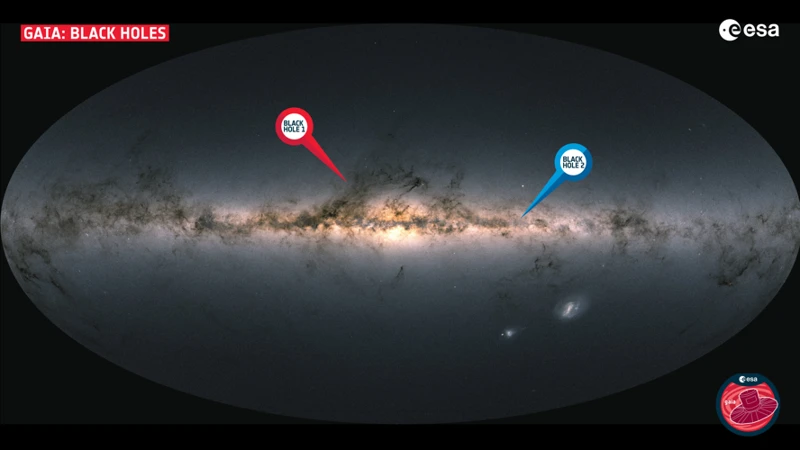
Black holes are cosmic entities that possess gravitational forces so strong that nothing, not even light, can escape their grasp. They are formed from the remnants of massive stars undergoing gravitational collapse. As a star exhausts its nuclear fuel, its core collapses under the force of gravity, leading to the formation of a black hole. Within a black hole, there exists an infinitesimally small, infinitely dense region called the singularity, where all the mass of the star is concentrated. Surrounding the singularity is the event horizon, which marks the boundary beyond which nothing can escape. The concept of a black hole is mind-boggling and defies our intuitive understanding of space and time.
Black holes can form through two main processes: stellar collapse and supermassive black hole formation. Stellar black holes form when a massive star, typically at least three times the mass of the Sun, exhausts its nuclear fuel and undergoes a supernova explosion. The core that remains collapses under gravity, forming a stellar black hole. On the other hand, supermassive black holes, with masses millions or billions of times that of the Sun, are thought to be formed through the gradual accumulation of mass over time. The exact mechanisms behind their formation are still not fully understood.
Black holes possess several intriguing properties. One of the most captivating is their gravitational pull, which is so strong that it warps the fabric of space and time around them. This phenomenon, known as spacetime curvature, leads to the famous “bending” of light near black holes. Another noteworthy property is their size, which is determined by their mass. The more massive a black hole, the larger its event horizon. Despite their incredible gravitational force, black holes themselves do not have a measurable size, as their mass is compressed into a singularity. These peculiar characteristics make black holes one of the most intriguing cosmic phenomena to study and understand.
To explore more about the wonders of the cosmos, check out our article on comets, asteroids, and meteor showers. Or, if you’re interested in discovering ancient mythologies in the night sky, read our article on uncovering ancient constellations. And for those curious about one of the most famous constellations, read about the Great Bear and Ursa Minor.
1.1 What is a Black Hole?
A black hole is an extraordinary cosmic entity that possesses unimaginable gravitational power. It is a region in space where matter has collapsed under its own weight, resulting in an immense gravitational pull that nothing, not even light, can escape. Black holes were first theorized by Albert Einstein’s theory of general relativity, which describes the curvature of spacetime caused by mass and energy.
At the heart of a black hole lies its singularity, a point of infinite density where the laws of physics, as we currently understand them, break down. The singularity is surrounded by an event horizon, which acts as the point of no return. Once anything crosses this boundary, it is irreversibly pulled into the black hole’s gravitational grip. The size of the event horizon is determined by the mass of the black hole.
Black holes come in different sizes, ranging from stellar black holes to supermassive black holes. Stellar black holes form from the remnants of massive stars, usually with masses several times that of the Sun. They are relatively small, with event horizons typically a few kilometers in diameter. On the other hand, supermassive black holes, found at the centers of galaxies, have masses millions or even billions of times that of the Sun. Their event horizons can extend for millions of kilometers.
Despite their menacing nature, black holes do not constantly devour everything in their vicinity. In fact, objects can orbit a black hole just as planets orbit a star, as long as they remain outside the event horizon. These orbits can be stable and can even allow the formation of accretion disks, consisting of matter spiraling around the black hole before eventually falling in.
Understanding the nature of black holes has been a subject of intense scientific research and exploration. Their enigmatic properties, such as their ability to emit Hawking radiation, continue to challenge our understanding of the fundamental laws of physics. The study of black holes allows us to delve deeper into the intricate nature of spacetime and the mysteries that lie within our vast universe.
1.2 Formation and Properties of Black Holes
Black holes are fascinating cosmic phenomena that form through the collapse of massive stars. When a star with a mass several times greater than that of the Sun reaches the end of its life, it undergoes a supernova explosion. During this explosive event, the outer layers of the star are expelled into space, leaving behind a dense core. If the core’s mass is greater than about 3 times the mass of the Sun, it collapses under the force of gravity, forming a black hole.
The size of a black hole depends on its mass. Smaller black holes, known as stellar black holes, have masses ranging from a few times that of the Sun to a few tens of times that of the Sun. These black holes have relatively small event horizons, the region beyond which nothing can escape their gravitational pull.
Supermassive black holes, on the other hand, have masses that are millions or even billions of times greater than that of the Sun. These colossal black holes are thought to exist at the centers of most galaxies, including our own Milky Way. The exact process by which supermassive black holes form is still a subject of scientific investigation, but theories suggest that they may grow over time through the accretion of mass from surrounding matter or through the merging of smaller black holes.
One of the remarkable properties of black holes is their gravitational strength. The gravitational force near a black hole is so intense that it distorts the fabric of spacetime itself. This effect, known as gravitational lensing, causes light to bend as it passes near a black hole. It also results in time dilation, where time appears to slow down for an outside observer compared to someone closer to the black hole’s strong gravitational pull.
Another fascinating property of black holes is their ability to emit radiation. This phenomenon, known as Hawking radiation, arises from quantum mechanical effects near the event horizon. Despite their intense gravitational pull, black holes can gradually lose mass over time due to the emission of this radiation.
To summarize, black holes form through stellar collapse and can have a wide range of sizes and masses. They possess extraordinary gravitational forces that can bend light and distort spacetime. Supermassive black holes are thought to exist at the centers of galaxies, while stellar black holes form from the remnants of massive stars. The study of black holes continues to deepen our understanding of the fundamental laws of physics and the nature of the universe itself.
Black Hole Mergers: Theoretical Framework
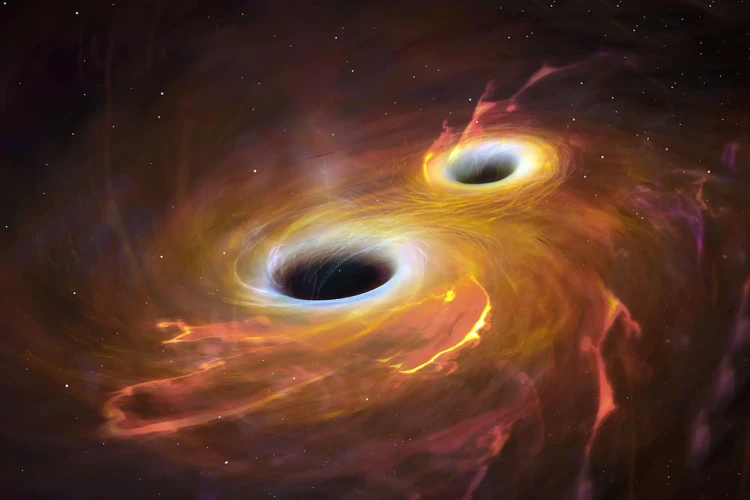
Black hole mergers occur when two black holes come into close proximity and eventually combine to form a single, more massive black hole. The theoretical framework for understanding black hole mergers is rooted in Einstein’s general theory of relativity, which describes gravity as the curvature of spacetime caused by massive objects. According to this theory, when two black holes approach each other, their immense gravitational forces cause a disturbance in the fabric of spacetime, creating ripples known as gravitational waves. The emission of gravitational waves is a fundamental prediction of general relativity and serves as a key indicator of black hole mergers.
The process of black hole mergers begins with the approach and orbital motion of two black holes, typically resulting from the gravitational interactions within a dense stellar environment or through the interaction of galaxies. As the black holes move closer together, they begin to emit gravitational waves, carrying away energy and causing their orbits to decay. This gradual inspiral leads to a critical point known as the “innermost stable circular orbit” (ISCO), beyond which the black holes no longer maintain a stable orbit and rapidly plunge towards each other. In the final moments of the merger, the black holes collide and merge into a single, more massive black hole, releasing an enormous amount of energy in the form of gravitational waves.
The study of black hole mergers and the detection of gravitational waves have experienced significant advancements in recent years. The groundbreaking work of the Laser Interferometer Gravitational-Wave Observatory (LIGO) Scientific Collaboration has led to the direct detection of several black hole merger events. LIGO consists of two observatories, one located in Livingston, Louisiana, and the other in Hanford, Washington. By measuring tiny distortions in the length of laser beams caused by gravitational waves, LIGO has detected the distinctive signals produced by black hole mergers.
To gain further insights into the detection and characteristics of black hole mergers, scientists are continuously refining theoretical models and conducting complex simulations. These simulations involve solving Einstein’s equations numerically, using supercomputers to simulate the dynamics of black hole mergers. These simulations help scientists understand the detailed evolution of the merger process, the emission of gravitational waves, and the properties of the resulting black hole.
Understanding the theoretical framework of black hole mergers is crucial for interpreting observational data and expanding our knowledge of the cosmos. As technological advancements continue to improve the sensitivity of gravitational wave detectors and simulations become more sophisticated, we are on the cusp of unlocking even more secrets about the nature of black hole mergers and their implications for our understanding of the Universe.
2.1 How Do Black Hole Mergers Occur?
Black hole mergers occur when two black holes come into close proximity to each other, eventually spiraling toward each other due to their gravitational attraction. This process is commonly referred to as a binary black hole system. The formation of a binary black hole system can happen in a few different ways. One scenario involves two separate black holes existing in a cluster of stars. Over time, gravitational interactions between the black holes and other stars can cause the binary system to form. Another possibility is the merger of two galaxies, each containing a black hole. As the galaxies collide and merge, their respective black holes can be brought close together and form a binary system.
Once a binary black hole system is formed, the two black holes begin a mesmerizing dance around each other. This dance is driven by the emission of gravitational waves – ripples in the fabric of space-time itself. As the black holes orbit each other, they lose energy in the form of gravitational waves, causing them to gradually spiral closer together. This process can take millions or even billions of years, depending on the mass and separation of the black holes.
As the black holes approach each other, their gravitational pull intensifies, causing them to accelerate and release even stronger gravitational waves. Eventually, they reach a critical point known as the “last stable orbit.” At this stage, the black holes are so close together that their event horizons begin to overlap. Finally, the two black holes merge into a single, more massive black hole. The energy liberated during the merger is released in the form of an intense burst of gravitational waves that ripple through the fabric of space-time.
To detect and study these elusive gravitational waves emitted by black hole mergers, scientists have developed specialized observatories such as the Laser Interferometer Gravitational-Wave Observatory (LIGO). These observatories utilize precision laser measurements to detect the tiny distortions caused by passing gravitational waves. By analyzing the characteristics of the detected waves, scientists can gain valuable insight into the properties and dynamics of black hole mergers, furthering our understanding of these cosmic phenomena.
Understanding how black hole mergers occur is just one piece of the puzzle in unraveling the mysteries of these enigmatic entities. In the next section, we will explore the fascinating world of gravitational waves and how they are instrumental in detecting black hole mergers.
2.2 Gravitational Waves: Detecting Black Hole Mergers
Gravitational waves, as predicted by Albert Einstein’s theory of general relativity, are ripples in the fabric of spacetime that propagate outward at the speed of light. These waves are generated by accelerating masses and cosmic events with strong gravitational effects, such as black hole mergers. Detecting and measuring gravitational waves has revolutionized our ability to study and understand black hole mergers.
The most advanced and successful instrument for detecting gravitational waves is the Laser Interferometer Gravitational-Wave Observatory (LIGO). LIGO consists of a network of observatories that are strategically positioned thousands of kilometers apart. Each observatory contains a pair of perpendicular arms that house extremely sensitive mirrors. When a gravitational wave passes through the observatory, it causes minute changes in the lengths of the arms, which is detected by laser interferometry. This precise technology allows LIGO to measure incredibly small changes in distance, on the scale of a thousandth the size of an atomic nucleus.
The detection of gravitational waves from black hole mergers has provided solid evidence for the existence of these cosmic collisions. The first direct observation occurred on September 14, 2015, when LIGO detected gravitational waves produced by the merger of two black holes, approximately 1.3 billion light-years away. This groundbreaking discovery confirmed Einstein’s theory and marked the beginning of a new era in astrophysics.
Since then, several other black hole mergers have been detected by LIGO, adding valuable data to our understanding of these cosmic events. Each observation provides insights into the masses and spins of the merging black holes, as well as the energy released in the form of gravitational waves. By analyzing the properties of these waves, scientists can deduce various characteristics of the merging black holes and gain valuable information about the nature of gravity and the laws of physics.
Gravitational wave detectors, such as LIGO, have significantly expanded our ability to detect not only black hole mergers but also other cataclysmic events in the universe. They allow us to study the behavior of matter and gravitational forces in extreme conditions, shedding light on the mysteries of black holes and the cosmos as a whole. The continued advancements in gravitational wave detection technology hold the promise of unveiling even more secrets and unlocking new realms of knowledge about black hole mergers and the universe beyond.
Observational Evidence of Black Hole Mergers
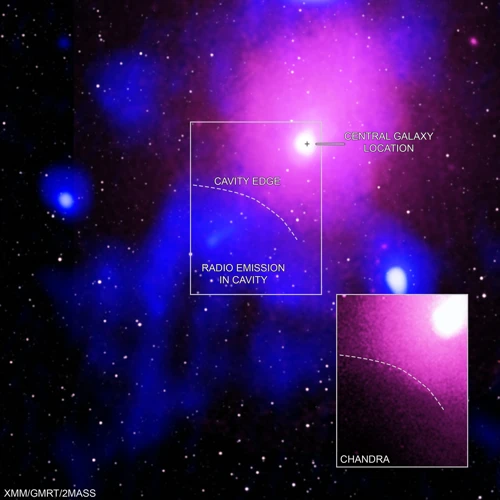
Observational evidence of black hole mergers has provided significant insights into these mysterious celestial events. The landmark discoveries made by the LIGO Scientific Collaboration (LSC) have revolutionized our understanding of black hole mergers. LIGO, which stands for the Laser Interferometer Gravitational-Wave Observatory, is a ground-based observatory consisting of two detectors located in the United States.
The detection of black hole mergers is made possible by the observation of gravitational waves – ripples in the fabric of spacetime caused by the violent merger of black holes. These gravitational waves carry information about the mass, spin, and distance of the merging black holes.
Since its inception, LIGO has detected several notable black hole merger events. One such event, named GW150914, was the first direct detection of gravitational waves from the merger of two black holes. This groundbreaking discovery, announced in 2016, confirmed the existence of gravitational waves and opened up a new window for studying the cosmos.
Subsequent observations by LIGO have uncovered additional black hole merger events, each providing valuable data and expanding our knowledge of these cosmic phenomena. Notable examples include GW170104, GW170608, and GW170814, which represented significant advancements in our ability to detect and study black hole mergers.
The data collected from these observations has allowed scientists to study the properties of black holes, such as their masses and spins. It has also provided insight into the frequency of black hole mergers in the universe. By analyzing the gravitational wave signals, researchers can determine the parameters of the merging black holes and infer the astrophysical processes involved.
The detection and study of black hole mergers through gravitational waves have provided observational evidence that supports the theoretical framework of black hole mergers. These groundbreaking findings have not only confirmed the existence of black holes but also shed light on their formation, evolution, and dynamics.
| Notable Black Hole Merger Observations | Date | Detected Gravitational Wave Signal |
|---|---|---|
| GW150914 | September 14, 2015 | First direct detection of gravitational waves from black hole merger |
| GW170104 | January 4, 2017 | Detection of a black hole merger with high mass and low spin |
| GW170608 | June 8, 2017 | Detection of the merger of a relatively light black hole with a heavier one |
| GW170814 | August 14, 2017 | Detection of the merger of two black holes with significantly unequal masses |
3.1 The LIGO Scientific Collaboration
The LIGO Scientific Collaboration (LSC) is an international research network dedicated to the detection and study of gravitational waves. LIGO, which stands for Laser Interferometer Gravitational-Wave Observatory, is the primary instrument used by the LSC to detect these elusive waves. The LSC consists of a diverse group of scientists, engineers, and institutions from around the world, all working together to unravel the secrets of the universe through the study of black hole mergers and other cosmic events.
LIGO operates through a network of two observatories, one located in Hanford, Washington, and the other in Livingston, Louisiana. Each observatory consists of a pair of perpendicular arms, several kilometers in length, in which laser beams are split and then recombined. Gravitational waves passing through the observatories cause minute changes in the length of the arms, which can be detected by sensitive instruments.
The construction and operation of LIGO required a massive collaborative effort. The LSC brought together scientists from various fields, including physics, astronomy, and engineering, to design and build the advanced detectors. The observatories underwent extensive upgrades to increase their sensitivity, reaching a level capable of detecting the subtle distortions caused by gravitational waves.
In September 2015, the LSC made history by announcing the first direct detection of gravitational waves, confirming a prediction made by Albert Einstein a century earlier. This groundbreaking detection, known as GW150914, was a result of the merger of two black holes, with one about 36 times the mass of the Sun and the other about 29 times the mass of the Sun. The detection of this event provided strong evidence for the existence of black hole mergers and opened up a new era in astrophysics.
Since then, the LSC has made several more notable detections of black hole mergers, further expanding our understanding of these cosmic phenomena. Collaboration with other observatories, such as the European Virgo detector, has allowed for more precise localization of the sources and improved characterization of the gravitational wave signals.
The LSC continues to push the boundaries of gravitational wave astronomy, with ongoing research aimed at enhancing detector sensitivity, improving data analysis techniques, and expanding the capabilities of the instruments. By studying black hole mergers and other gravitational wave sources, the LSC is helping unravel the mysteries of the universe and advancing our knowledge of fundamental physics.

Unanswered Questions and Current Research
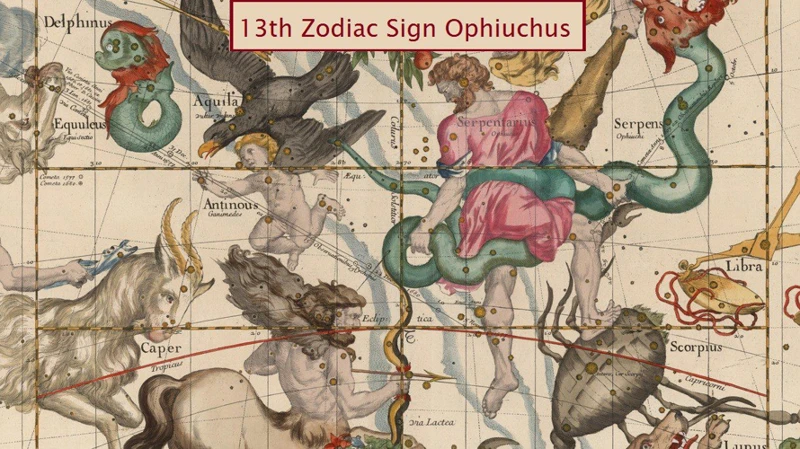
Unanswered questions surround the fascinating phenomenon of black hole mergers, leaving scientists eager to uncover more about these cosmic events. One area of ongoing research is the study of post-merger effects and remnants. When two black holes merge, they create a larger black hole, releasing a tremendous amount of energy in the form of gravitational waves. Scientists are intrigued by what happens after this merger. Do these newly formed black holes exhibit any unique characteristics? Are there any observable remnants or signatures left behind? These questions drive researchers to study the dynamics and evolution of black holes after they merge.
Another area of current research focuses on the collision of supermassive black holes. These colossal black holes, found at the centers of galaxies, are thought to grow through mergers with other black holes and the accretion of matter. Scientists aim to understand the complex dynamics of these collisions, as they can have profound effects on the surrounding galaxies. The interactions between supermassive black holes and their host galaxies play a crucial role in shaping the structure and evolution of galaxies over cosmic timescales. Studies of these collisions may offer valuable insights into the formation and growth of galaxies.
Advancements in technology are providing new avenues for investigating black hole mergers. Theoretical models and simulations, coupled with the detection of gravitational waves, have revolutionized our ability to study these cosmic phenomena. The implementation of pioneering instruments like the Laser Interferometer Gravitational-Wave Observatory (LIGO) has enabled the direct detection of gravitational waves emitted during black hole mergers. Continued improvements in these technologies hold the potential to further expand our understanding of these enigmatic events.
Black hole mergers continue to intrigue scientists, and current research is focused on unraveling the unanswered questions surrounding these cosmic phenomena. Investigations into the post-merger effects and remnants of black holes, as well as the collisions of supermassive black holes, are pushing the boundaries of our knowledge. Advancements in technology and the detection of gravitational waves have opened new avenues for exploration. As scientists delve deeper into the mysteries of black hole mergers, our understanding of the cosmos and the fundamental laws of physics may undergo profound transformations.
4.1 Post-Merger Effects and Remnants
When two black holes merge, a cataclysmic event occurs that leaves behind fascinating post-merger effects and remnants. The violent collision produces tremendous amounts of energy in the form of gravitational waves. These gravitational waves ripple through spacetime, carrying valuable information about the merger process.
One of the post-merger effects is the emission of a final burst of gravitational waves known as the ringdown. This phenomenon occurs as the newly formed black hole settles down into a more stable state after the merger. The ringdown signal can provide insights into the properties of the final black hole, such as its mass and spin.
Additionally, the merger can result in the formation of an accretion disk. As the two black holes spiral inward towards each other, they generate immense tidal forces that can tear apart nearby matter, such as gas and dust. This material then accumulates around the newly formed black hole, forming a swirling disk of hot, glowing matter. The accretion disk can release enormous amounts of energy in the form of X-rays and other electromagnetic radiation. Observing these emissions can help astronomers better understand the properties of the merged black hole.
In some cases, the merger can also launch a powerful jet of high-energy particles. As the black holes merge, they can spin rapidly, creating a strong magnetic field. This magnetic field can channel matter and energy outward in the form of narrow streams, or jets, traveling at relativistic speeds. These jets can extend for thousands of light-years and have a significant impact on the surrounding environment. Studying these jets can shed light on the interplay between black hole mergers and the evolution of galaxies.
In the aftermath of a black hole merger, remnants of the original black holes may also persist. For example, if the merging black holes have substantial angular momentum, they can form a distorted, spinning black hole called a Kerr black hole. Kerr black holes possess intriguing properties, such as the ability to create a “rotating frame-dragging effect” known as the Lense-Thirring effect. This effect influences the motion of nearby objects, providing another avenue for studying the aftermath of black hole mergers.
Understanding the post-merger effects and remnants is crucial for unraveling the intricate dynamics of black hole mergers. It allows us to gain valuable insights into the physics of these cosmic events and further our understanding of the nature of black holes themselves.
4.2 Colliding Worlds: Supermassive Black Holes
Supermassive black holes, as the name suggests, are black holes with masses that are millions or billions of times greater than that of the Sun. These enigmatic cosmic giants reside at the centers of most, if not all, galaxies, including our own Milky Way. The formation of supermassive black holes is still a subject of active research and remains an open question in astrophysics.
One prominent theory suggests that supermassive black holes grow through the gradual accumulation of mass over time. As galaxies collide and merge, their central black holes, if present, can also merge, resulting in a larger, more massive black hole. This process, known as black hole coalescence, is thought to be one of the key mechanisms behind the formation of supermassive black holes. The merger of galaxies brings their black holes closer together, eventually leading to their gravitational attraction and subsequent fusion into a single, more massive black hole.
Observing supermassive black hole mergers directly is challenging due to their immense distances and timescales. However, scientists have been able to indirectly infer the existence of merging supermassive black holes through various techniques. One notable method is the detection of gravitational waves, ripples in the fabric of spacetime caused by the acceleration of massive objects. Advanced gravitational wave detectors, such as the Laser Interferometer Gravitational-Wave Observatory (LIGO), have the potential to detect the gravitational waves produced by colliding supermassive black holes.
The detection of a supermassive black hole merger would provide invaluable insights into the formation and evolution of galaxies. It could help scientists understand how galaxies evolve over cosmic time, influencing the growth of stars and the interstellar medium. These mergers release tremendous amounts of energy and can shape the structures of galaxies, including their shapes and distributions of gas and stars.
Studying supermassive black hole mergers also sheds light on the mysteries of gravity and general relativity. The extreme conditions near these massive objects allow us to test the limits of our understanding of gravity and its behavior in the presence of such intense gravitational fields. Confirming the existence of colliding supermassive black holes would provide strong evidence for the theory of general relativity, introduced by Albert Einstein over a century ago.
Supermassive black hole mergers are captivating phenomena that offer a glimpse into the intricate dynamics of galaxies and the nature of gravity itself. They represent cosmic collisions on the grandest scales, shaping the evolution of galaxies and providing scientists with a deeper understanding of the universe.
4.3 The Future of Black Hole Merger Research
The future of black hole merger research holds immense potential for furthering our understanding of these cosmic phenomena. As technology continues to advance, scientists anticipate that more advanced detectors and instruments will be developed to observe and study black hole mergers in even greater detail. One area of focus is improving gravitational wave detectors, such as the Laser Interferometer Space Antenna (LISA), which is expected to be able to detect lower-frequency gravitational waves than current ground-based detectors like LIGO.
Additionally, upcoming space missions like the European Space Agency’s Athena and NASA’s Lynx X-ray Observatory aim to explore the X-ray emission from black holes. These missions will provide valuable insights into the accretion disks and jets associated with black hole mergers, shedding light on the processes occurring during and after the merger event.
Ongoing theoretical research is dedicated to modeling and simulating black hole mergers using computer simulations. These simulations help predict the observational signatures of mergers and provide a framework for interpreting future observations.
Collaborations between astrophysicists, astronomers, and physicists from around the world continue to push the boundaries of knowledge in black hole merger research. By sharing data, expertise, and resources, these collaborations ensure that the field progresses and develops at an accelerated pace.
The future of black hole merger research is bright and promising. Advancements in technology, such as improved gravitational wave detectors and space missions dedicated to studying black holes, will contribute to our understanding of the mechanisms behind these cosmic collisions. The continued efforts of researchers and collaborations will pave the way for new discoveries and insights into the nature of black hole mergers.
If you’re interested in learning about other fascinating astronomical phenomena, check out our article on the role of comets, asteroids, and meteor showers or explore the mysteries of uncovering ancient constellations.
The Significance of Black Hole Mergers
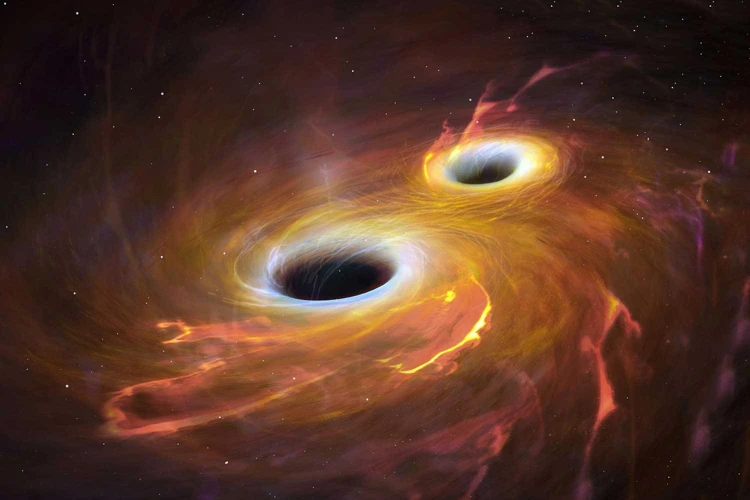
The significance of black hole mergers extends beyond the realm of astronomical curiosity. These cosmic collisions provide invaluable insights into fundamental aspects of physics, astrophysics, and the evolution of the universe.
Black hole mergers confirm the existence of gravitational waves, an elusive phenomenon predicted by Albert Einstein’s theory of general relativity. These ripples in the fabric of spacetime carry information about the masses, spins, and distances of the merging black holes, allowing us to probe the nature of gravity itself. By studying the gravitational waves emitted during a merger, scientists can test the predictions of general relativity and explore potential modifications or extensions to the theory.
Additionally, black hole mergers shed light on the formation and evolution of galaxies. It is believed that galaxies grow through mergers and interactions with other galaxies over cosmic timescales. The merger of supermassive black holes, which reside at the centers of galaxies, has a profound impact on the dynamics and properties of their host galaxies. These colossal collisions can trigger star formation, shape the distribution of gas and stars, and influence the growth of the galaxies themselves. By studying black hole mergers, scientists gain a deeper understanding of the intricate relationship between black holes and galaxies, unraveling the cosmic dance that shapes the universe.
It is worth noting that the detection and study of black hole mergers have only just begun with the advent of gravitational wave observatories like the Laser Interferometer Gravitational-Wave Observatory (LIGO) and the Virgo detector. As technology improves and new observatories come online, our ability to detect and analyze these cosmic events will improve drastically. This opens up exciting prospects for future discoveries and breakthroughs in our quest to understand the mysteries of the universe.
So, as we continue to unravel the secrets of black hole mergers, we simultaneously unlock the mysteries of gravity, explore the evolution of galaxies, and deepen our understanding of the cosmos itself. The significance of these awe-inspiring celestial phenomena stretches far beyond their mesmerizing beauty, connecting us to the very fabric of the universe we inhabit.
5.1 Insights into General Relativity and Beyond
One of the most significant contributions of black hole mergers is the insights they provide into the theory of general relativity and beyond. General relativity, formulated by Albert Einstein, describes gravity as the curvature of spacetime caused by the presence of mass and energy. The merger of black holes allows scientists to observe the intricacies of gravity in extreme conditions that were previously inaccessible. By analyzing the gravitational waves emitted during a merger, researchers can test the predictions of general relativity and explore its validity in the most extreme environments.
Black hole mergers also hold the potential to reveal new physics beyond general relativity. These cosmic events provide an opportunity to study phenomena such as the nature of spacetime itself, the existence of extra dimensions, and the potential connection between gravity and quantum mechanics. The study of black hole mergers allows scientists to push the boundaries of our current understanding of the universe and potentially uncover revolutionary concepts that may shape the future of physics.
The analysis of gravitational waves from black hole mergers can lead to the discovery of exotic objects and phenomena. For example, the observation of gravitational waves can provide evidence for the existence of hypothetical objects like primordial black holes or even unconventional entities like wormholes. These findings would have far-reaching implications for our understanding of the nature of the universe and its fundamental building blocks.
The study of black hole mergers offers valuable insights into the theory of general relativity, allowing scientists to test its predictions and explore new physics beyond its scope. These groundbreaking observations provide a window into the extreme environments where gravity reigns supreme, enabling us to unravel the mysteries of the universe and potentially reshape our understanding of reality itself.
5.2 Formation of Galaxies and Cosmological Evolution
The formation of galaxies and the process of cosmological evolution are intricately tied to the phenomenon of black hole mergers. Black holes, through their mergers, play a crucial role in shaping the structure and evolution of galaxies throughout the cosmos.
In the early stages of our universe, small density fluctuations led to the formation of primordial galaxies. Within these galaxies, black hole seeds formed through the collapse of massive stars. Over time, these black holes grew in mass through accretion, where they consumed surrounding matter. As the black holes grew, they interacted with their host galaxies, influencing their evolution.
As black holes merge, they release an enormous amount of energy in the form of gravitational waves. These waves, as they propagate through the surrounding space, carry away energy and angular momentum, causing the black holes to spiral closer and closer together. Eventually, the black holes coalesce into a single, more massive black hole. This merger process has a significant impact on the host galaxy.
The release of gravitational waves during black hole mergers can drive gas and dust out of the galaxy, affecting the rate of star formation. Additionally, the merger can trigger intense bursts of star formation as the galactic material is compressed and heated during the gravitational dance of the merging black holes. These bursts of star formation can lead to the creation of globular clusters, which are dense groups of stars bound together by gravity.
Black hole mergers can also disrupt the galactic structure and alter the distribution of stars and gas. The gravitational interactions during mergers can cause the redistribution of matter, resulting in the formation of tidal tails, tidal bridges, and other tidal structures. These structures provide evidence of past merger events and help astronomers understand the history of galaxy interactions in the universe.
Through the study of black hole mergers and their impact on galaxies, scientists gain insight into the processes driving galaxy formation and cosmological evolution. It allows them to understand how galaxies go through stages of growth and transformation throughout the history of the universe. This knowledge provides a deeper understanding of the large-scale structure of the cosmos and the intricate dance between black holes and galaxies that shapes our cosmic environment.
To explore more about the wonders of the cosmos, check out our article on comets, asteroids, and meteor showers. Or, if you’re interested in discovering ancient mythologies in the night sky, read our article on uncovering ancient constellations. And for those curious about one of the most famous constellations, read about the Great Bear and Ursa Minor.
Conclusion

In conclusion, the unraveling of black hole mergers has opened up new frontiers in our understanding of the universe and the laws of physics. Through the efforts of the LIGO Scientific Collaboration and other observatories, we have witnessed the detection of gravitational waves, providing direct evidence of black hole mergers. These monumental discoveries have not only confirmed Einstein’s theory of General Relativity but have also given us a glimpse into the intricate workings of the cosmos.
The study of black hole mergers has also shed light on the formation and evolution of galaxies. As black holes merge, they release enormous amounts of energy in the form of gravitational waves, which can stir up the surrounding gas and dust. This, in turn, can trigger the formation of new stars and influence the structure and dynamics of galaxies. By studying black hole mergers, we gain a deeper understanding of the interconnectedness between black holes, galaxies, and the vast cosmic web.
However, many questions about black hole mergers still remain unanswered. The post-merger effects and remnants of these cosmic collisions are still being actively researched. Additionally, the collision of supermassive black holes, which could lead to cataclysmic events, continues to be a topic of study and investigation.
Looking forward, the future of black hole merger research holds great promise. Advancements in technology and the expansion of observatories dedicated to studying gravitational waves will enable us to detect and study even more black hole mergers in the coming years. Continued research in this field will allow us to further refine our understanding of the nature of black holes, gravity, and the fundamental workings of the universe.
In conclusion, black hole mergers are extraordinary cosmic events that have captivated our imaginations and pushed the boundaries of our knowledge. They continue to inspire astronomers and scientists to unlock the secrets of the universe and offer remarkable insights into the depths of spacetime. As we delve further into the mysteries of black hole mergers, we will undoubtedly uncover even more astonishing revelations that shape our understanding of the cosmos.
Frequently Asked Questions

1. What happens if you fall into a black hole?
If you were to fall into a black hole, the intense gravitational pull would stretch your body due to a phenomenon called spaghettification. Eventually, you would reach the singularity, where all your mass would be compressed into an infinitely small point.
2. Can black holes die?
According to current theories, black holes do not die. However, they can slowly lose mass over time through a process called Hawking radiation.
3. How are black holes detected?
Black holes are primarily detected through their influence on nearby objects. Astronomers observe the gravitational effects of black holes on stars and gas clouds, or through the detection of their emission of X-rays or gravitational waves.
4. Do black holes move?
Black holes can move through space, but their motion is determined by their surrounding environment, such as the gravitational forces exerted by nearby stars or other black holes.
5. Can anything escape from a black hole?
Once inside the event horizon of a black hole, nothing, not even light, can escape its gravitational pull.
6. Are there different types of black holes?
Yes, there are different types of black holes. Stellar black holes are formed from the remnants of massive stars, while supermassive black holes reside at the centers of galaxies and have millions or billions of times the mass of the Sun.
7. Are black holes responsible for the formation of galaxies?
Black holes, particularly supermassive black holes, are thought to play a crucial role in the formation and evolution of galaxies. The gravitational influence of these black holes helps shape the structures and dynamics of galaxies.
8. How do black hole mergers generate gravitational waves?
During a black hole merger, the intense gravitational forces cause ripples in space-time, known as gravitational waves. These waves propagate through the universe, carrying information about the merger event.
9. Are there any black holes near our solar system?
There are no known black holes in our immediate vicinity, but there may be distant ones that are yet to be discovered.
10. Can a black hole destroy Earth?
No, a black hole cannot destroy Earth from a distance. For a black hole to pose a threat, it would need to come into close proximity to our planet, which is highly unlikely.
References
Frequently Asked Questions

FAQs About Black Hole Mergers
1. What happens when two black holes merge?
When two black holes merge, they create a single, more massive black hole. This process releases a tremendous amount of energy in the form of gravitational waves, causing ripples in the fabric of spacetime.
2. Can black holes merge with other celestial objects?
Black holes can merge with other black holes or compact objects, such as neutron stars. However, the merger of black holes with non-compact objects, like regular stars, is highly unlikely due to the vast difference in size and density.
3. How are black hole mergers detected?
Black hole mergers are detected using gravitational wave observatories like the Laser Interferometer Gravitational-Wave Observatory (LIGO) and the European Virgo detector. These observatories can measure the minute changes in spacetime caused by the merging black holes.
4. Are gravitational waves dangerous?
Gravitational waves are not dangerous to humans or Earth. The energy carried by gravitational waves is incredibly small by the time they reach us from distant black hole mergers, and they pass through matter without significant interactions.
5. How often do black hole mergers occur?
The frequency of black hole mergers in the universe is difficult to determine precisely. However, based on observations by the LIGO and Virgo detectors, scientists estimate that black hole mergers happen several times each month.
6. What happens to matter falling into a black hole during a merger?
During a black hole merger, any matter falling into the black holes is consumed by the resulting merged black hole. The immense gravitational pull of the black holes prevents any significant matter from escaping the event horizon.
7. Are there any remnants left after a black hole merger?
After a black hole merger, there are no remnants left that can easily be observed. The merged black hole continues to exist and interact with its surroundings, but any traces of individual constituents like event horizons or singularities are blended together.
8. Could black hole mergers pose a threat to our solar system?
Black hole mergers pose no direct threat to our solar system. The distances between black holes and our solar system are incredibly vast, and the effects of a merger are limited to the region immediately surrounding the black hole.
9. Do black hole mergers support the theory of relativity?
Yes, black hole mergers provide strong evidence for Albert Einstein’s general theory of relativity. The observations of gravitational waves during black hole mergers align very closely with the predictions made by the theory.
10. Can black hole mergers create new universes?
The creation of new universes through black hole mergers remains purely speculative in current scientific understanding. While black hole mergers have far-reaching effects, such as shaping galaxy formation, the creation of entirely new universes is still a topic of theoretical exploration.

